Book Review & Interview | Trappist Beer Travels
Trappist Beer Travels: Inside the Breweries of the Monasteries (Schiffer Publishing, 2017) by Caroline Wallace, Sarah Wood & Jessica Deahl
The world’s 11 Trappist breweries hold a mystique for beer drinkers that few other breweries can generate. Not only is the beer that is produced at these monasteries consistently excellent, but the remote and cloistered nature of these breweries blankets them in an air of mystery. Few of us will ever step inside the hallowed walls of these monastic breweries; the three authors of Trappist Beer Travels have been inside all of them.

Caroline Wallace, Sarah Wood, and Jessica Deahl, writers for the all-women-run beer blog Bitchbeer.org, came up with the idea for this book over a few pints of beer one night. Most of us have had beer-fueled conversations with friends about the ultimate brewery trip, but these three women turned one of these conversations into a once in a lifetime pilgrimage.
“The tons of spent grain generated are sent to local dairy farmers to sustain their cattle. We could not help but notice the cows in the region, apart from being incredibly well fed, were also very content looking specimens.” (Ch. 6: Chimay, page 100)
Trappist Beer Travels is a book the craft beer scene has needed for a long time. It’s amazing that until its release in May 2017, no English language book existed dedicated to the Trappist breweries. Wallace, Wood, and Deahl made this book on their own terms. This is not a quick and simple travel guide, though it does include necessary information for planning visits to these breweries. Trappist Beer Travels is a reverential reading experience, one that allows the reader to vicariously experience the sights, smells, tastes, and sounds of being in these sacred sites. Numerous full-color photographs take us inside monastery spaces that aren’t typically open to visitors, and extensive but enjoyable histories of each brewery give us context for these beers we so revere.
After an extensively researched introduction on the history of the Trappist order since its inception in the Middle Ages, the book devotes a chapter to each Trappist brewery, providing a full description of the property and facility for each, its history both as a monastery and a brewery, information about visiting, and descriptions of its beers. The authors provide a tremendous sense of place, allowing us to experience these settings along with them.
The information imparted from these monasteries is at times troublesome (only four monks remain at Achel), at times inspiring (the monks at Zundert launched their brewery specifically to more sustainably fund their charitable efforts), and at times exciting (Spencer, the first North American Trappist brewery, is poised for tremendous growth and diversification). It is uniformly fascinating.

The motto of Abbey Notre-Dame de Saint-Remy (better known at Rochefort), taken from the coat of arms of the abbot responsible for rebuilding the abbey after a war in the seventeenth century, is curvata resurgo—”Bent, I stand up again.” Reading Trappist Beer Travels, I was amazed at the ancient histories of these monasteries, the violence and hardship that has scarred their pasts, and the resilience of these dedicated men of faith who have repeatedly rebuilt their homes and recommitted themselves to service. These monasteries and their breweries will undoubtedly face more hard times, but we can take comfort they will always stand back up.
“Trappist monks are quiet men, to be sure, but they are not out of touch. They can see the world they have turned away from and appreciate its curiosity of their way of life. They do not have disdain or resentment toward their beers. In fact, they often see them as their conduit to the world outside. They are a tiny witness ot us of the brothers’ way of life and a small token of hope that we may glean a sliver of their deep connection to the absolute.” (Ch 13: Contemplation, page 200)
I recently had the chance to speak with Caroline, Sarah, and Jessica about their travels to these incredible monastic breweries and their experiences writing this book. After you read the interview below, check out the Trappist Beer Travels website and order a copy of this excellent book.
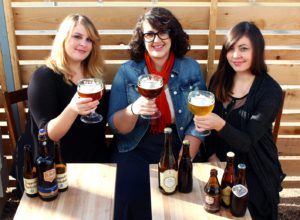
(David Nilsen for PorchDrinking) I know this is probably impossible to answer, but what was your favorite beer you tasted at a Trappist brewery? Which ones did you have for the first time at the breweries and really love?
Caroline Wallace: You’re right. It’s definitely impossible to pick. While we didn’t have a favorite per se because they are all just so different and well-crafted, getting to try Tre Fontane, the newest Trappist beer from Rome, stands out as a really special experience. While the three of us had sampled almost every other Trappist beer at some point over the years prior to the trip, we all felt really thankful and excited that we got to experience this amazing eucalyptus tripel at the monastery all together as a collective first.
Given the patronizing attitude many men have toward women in the American craft beer scene, were you apprehensive about how you would be received in the male-dominated spaces of these monasteries? Did you receive any kind of push-back, or was your experience entirely positive?
Caroline: I can’t speak to what their reaction was on the other end of the computer when they received our initial emails about the project, but our time at the monasteries was an incredibly positive experience overall and we were received with a lot of hospitality. The monks certainly had some curiosity about why we chose to take this trip, conduct these interviews, and write this book, but it didn’t seem to stem from our gender any more than from the fact that we’re Americans, we’re secular, and we’re perhaps a little younger (and, okay, more feminine) than writers like Michael Jackson and Jef Van den Steen who have been the ones to chronicle their stories in the past. We have definitely encountered some sexism in our normal lives and in the beer world from time to time, but it didn’t really rear its head in this project.
Sarah Wood: There was a fun moment when a monk told us he’d googled our blog “Bitch Beer” and asked us to speak more to it. It caught us totally off-guard because how do you ever prepare yourself to hear a monk say “bitch?” Later at that abbey, they told us they’d seen an increase in the number of women who visit their cafe to enjoy the beers in recent years, which I can safely say we were all tickled to hear.
I had no idea Orval has a female brewmaster! Did you get a chance to talk to Anne-Francoise Pypaert while you were there?
Sarah: We ran into her by chance on our tour of the brewery while coming down the stairs! We were all so star-struck and tongue-tied, we could barely get our words of admiration out. She runs both the brewing operation and the cheese-making, two things we are very much for. She mentioned that she admired the fact that we were taking on writing a book about Trappist beers and I died a little.
When do you think we might see our first Trappistine brewery? Have you heard rumors of any possibilities?
Jessica Deahl: That would definitely be exciting! We haven’t heard any whispers of a Trappistine brewery in the works.
Caroline: Last year I actually got to meet a Franciscan nun in Germany who is an incredible brewer. Her name is Sister Doris and her brewery is called Mallersdorf Abbey. While a Trappistine brewery would certainly be amazing, Sister Doris is holding it down as the world’s most infamous brewing nun in the meantime.
Beyond the lack of a language barrier, what differences did you notice between Spencer Brewery (the first North American Trappist brewery) and the ten European Trappist sites you visited?
Sarah: There is something to be said about the nonverbal communication and nuanced tones you get when having a conversation in your native language. After being abroad for nearly a month, I don’t think we noticed how much we’d missed those subtleties in communication—that is, until we started talking to Father Isaac. He had a way of conveying parts of the Abbey’s history like he was telling a secret to a close friend and we felt instantly welcome in the brewery as he talked with us.
Caroline: And then in terms of the beers themselves, the biggest difference we noticed was definitely that Spencer is straddling this very interesting line between paying homage to the techniques and traditions of the Belgian Trappists (which influenced their decision to launch with a patersbier), but they also have this real American craft beer spirit. They have a pilot system, which is pretty much unheard of for a Trappist brewery since most tend to stick to a relatively small portfolio of styles, and they’ve brewed beers like an IPA, an Imperial Stout, and a Pilsner in addition to the Belgian styles.

Sarah: They also showed us this amazing sensory library filled with spices and dried fruits and all sort of odds and ends to inspire their brewing staff.
While I knew the Trappists put their profits into charitable work, I found it inspiring in your book to learn that Zundert (Netherlands) started their brewing operation specifically to generate money for those in need in their community. How do you feel that philosophy affects the brewing operations there?
Sarah: While many Trappist abbeys find opportunities to support their local communities, Zundert has a really interesting perspective, as the Community only made the decision to start brewing in 2008 and the monks there today are very active participants in the brewing process, so the connection between the location and the beer is very tangible to them. That was clear, honestly, in each part of their story.
Brother Christiaan and Brother Guido told us the towns and the surrounding Dutch culture in general helped flavor the beer even before a recipe had been put on paper through word-mapping exercises and concepting in the brewery’s earliest phases. The location of the abbey plays a subtle role in each part of the beer-making process today, through the addition of large, diffused windows in the brewhouse to connect the brewers to the outdoors, the very quiet nod to the keystones over the cloister windows in the beer’s label, and through their local charities set up for those in need. It’s really special that they were able to make this decision to brew that not only allowed the Community to sustain it’s own way of life but also help sustain those in the areas around it that rely on their help. They’ve built into the very foundation of the beer reminders of that area and those people.
What were the biggest surprises for you on this trip, either at an individual brewery or as a whole from your travels?
Sarah: The monks we toured with, by and large, had an incredibly quick wit and a knack for jokes. For example, while we walking through the warehouse at La Trappe on our tour with Brother Isaac, the laymen brewery workers were playing loud electronica house music (as one does while packing heavy kegs and cases of beer). Father Isaac, not missing a beat, said, “We asked them to play Gregorian chants instead, but…” and trailed off with a “what’re you gonna do?” sort of gesture. His comedic timing was perfect. They aren’t just these reserved men, reluctant and somber. There is depth and warmth and grit to them, and—in the right moments—a pretty wicked sense of humor to boot.
Finally, if you were forced to pick, did you have a favorite monastery you visited?
Caroline: We know it sounds cliche, but really, truly all of the monasteries were unique, and fascinating, and welcoming, and beautiful in their own ways, so it is very difficult to answer that. Hopefully all of the stories and photographs and illustrations in the book really capture that. I will say, a lot of beer nerds want to hear about Westvleteren, and that’s understandable. It’s a brewery that has built a reputation based not only on quality, but on scarcity and elusiveness, so getting to walk through the infamous gate and see where those legendary beers are made was just a pretty humbling experience. As an aside, I never thought I could feel starstruck from seeing a phone, but getting to see in person the phone that probably now millions of people have called over the years in hopes of getting to pick up a case of beer from the abbey, well that was just as surreal as it was to see inside the brewhouse itself.
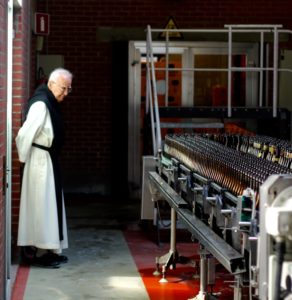
Sarah: While I largely agree with Caroline (it’s like picking a favorite beer or a favorite song—they are so different and mean such different things when you experience them) there were certain spaces that spoke to me on a deeper level. This was explained a little bit when, at one of the abbeys, a brother told us that the monastery location a monk chooses is as important in his decision to join as the makeup of the Community itself. That is why when a Community is uprooted, either by war or fire or some other tragedy, it is doubly tragic for that group. They are losing not just the walls they call home, but the space that drew them to this very challenging way of life in the first place.
That’s a really sad way to describe my attachment to certain spots, so I’ll try to illustrate it with a more joyful story. While visiting the brewery at Spencer, Father Isaac told us that when a brother from Saint Joseph’s Abbey visited Saint-Sixtus in Westvleteren, the Prior there greeted them by saying, “Oh, our eldest daughter is here!” He did so to acknowledge the time in 1860 when 15 brothers left Saint-Sixtus to help fortify the Community that eventually came to live at Saint Joseph’s Abbey. That split in the Community in 1860 left such a mark that it shaped the way the brothers from both Communities greeted each other over 200 years later. It was a homecoming of sorts for them; a reunion. Cue the tears, right?
I won’t say I’m cut out to take on the life of a Trappistine nun, but I did understand at some locations, in a very limited capacity, what the brother meant when he said the location of the monastery is as important as the Community that inhabits it to the monks that choose to be there.
Jessica: It’s like you’re asking us to pick a favorite child! As Caroline and Sarah mention, each monastery is distinct and wonderful and interesting in its own way. Collecting the stories of the monks at the places they live, pray, and work daily brought us all a deeper understanding and reverence for their lives and their brews. Picking one just seems unfair. I’ll take a cue from Sarah and speak a little about a monastery that touched me on a deeper level. Tre Fontane Abbey in Rome was so beautifully, quintessentially, romantically Italian in the best possible way. It’s the newest official Trappist monastery brewery (2015), but the abbey’s roots go back to biblical times. They produce eucalittino (a eucalyptus liqueur) from eucalyptus grown at the monastery, which informed their decision to brew a delightfully unique and aromatic eucalyptus tripel. Visiting this monastery brewery in its infancy and speaking with them about the history alongside day-to-day operations was a real treat for me.


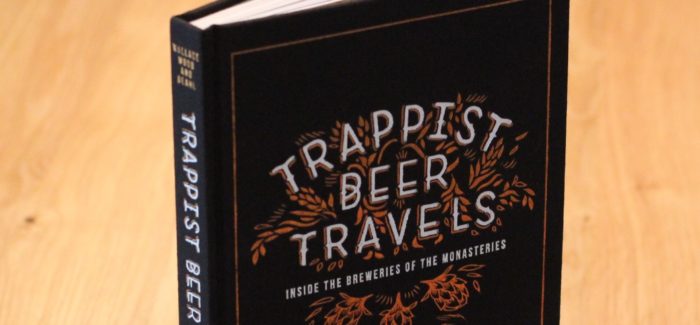

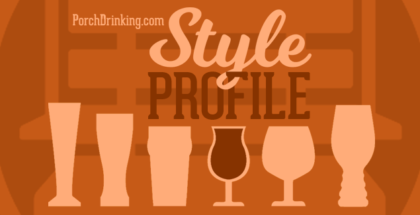
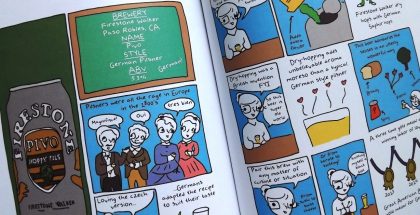
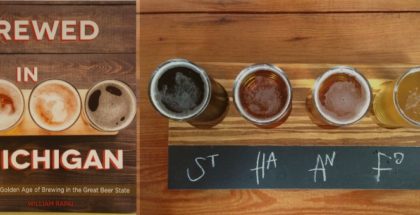
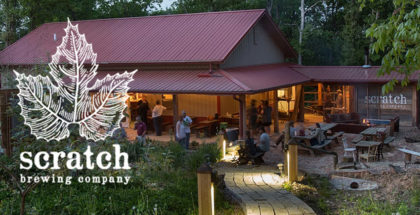
Submit a Comment